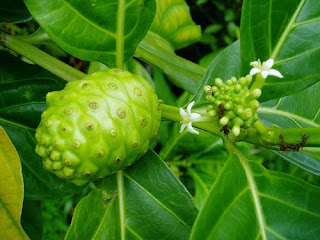Mengkudu (Morinda citrifolia) or keumeudee (Aceh); pace, bentes (java) cangkudu (Sunda); kodhuk (Madura); tibah (Bali) from the Southeast Asia region, belonging to the family Rubiaceae. Another name for this plant is noni (Hawaii), nono (Tahiti), Nonu (Tonga), ungcoikan (Myanmar) and ach (Hindi).
These plants grow in the lowlands up at an altitude of 1500 m. Noni tree height reaches 3-8 m, has a white flower head. The fruit is a fruit compound, which is still young and has a glossy green spots, and when the old white with black spots.
Traditionally, the people of Aceh to use noni as a vegetable and salad. The leaves are also used as an ingredient nicah peugaga which often appears as a mandatory menu iftar. Therefore, noni is often planted near homes in the countryside in Aceh. Besides noni is also often used as a medicine.1
General characteristics
Mengkudu/noni/Morinda Citrifolia tree is not so large, between 4-6 m high. trunk twisted, branchy stiff, coarse, and has a taproot that stuck in. The bark is grayish-brown or yellowish-brown kuniangan, split in shallow, not feathered, four bersegai its subsidiaries. Suklalu canopy of green all year round. Wood noni easily cleaved after drying. Can be used for supporting the Mengkudu thick leafy shiny. Noni leaf is face to face. Large leaf size, thickness, and single. Oblong-lanceolate shape, measuring 15-50 x 5-17 cm. The average leaf edges, short tapered ends. The base of the wedge-shaped leaves. Pinnate leaf veins. Hiaju shiny color, not fluffy. Short leaf base, measuring 0.5 to 2.5 cm. Fulcrum leaf size varies, triangular shaped width. Noni leaves can be eaten as a vegetable. High nutritional value because it contains vitamin A. that he can cure ambein. Flowers are arranged plural, round head-type inflorescence, stemmed 1-4 cm, grow in axillary fulcrum dealing with leaves that grow normally. Pansy flowers, petals white, funnel-shaped, the length can reach 1.5 cm. Stamens stuck in the mouth of the crown. Anthers berputing two. The flowers bloom from the petals shaped like bunches. The flowers are white, fragrant.Fruit compound, formed from would-fused ovaries and excrescence on the inside; fruit development stages following the interest that begins the process of expansion of the tip toward the base of the hump; 7.5 to 10 cm diameter. Compound fruit surface as divided into polygonal boundaries (polygons) are speckled and warty, which comes from the rest of the ovaries sole. Green color when mengkal, before cooking to a yellowish white, and finally pale white when ripe. Soft fruit flesh, composed of fruits pyramid-shaped stone with white flesh, formed from mesokarp. Fruit flesh contains a lot of water that smells like rotten cheese or goat odor arising due to mixing between capric acid (a fatty acid with ten carbon atoms), C10), caproic acid (C6), and caprylic acid (C8). Suspected last two compounds are active an


No comments:
Post a Comment